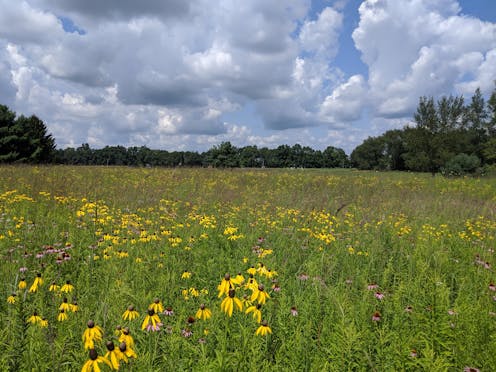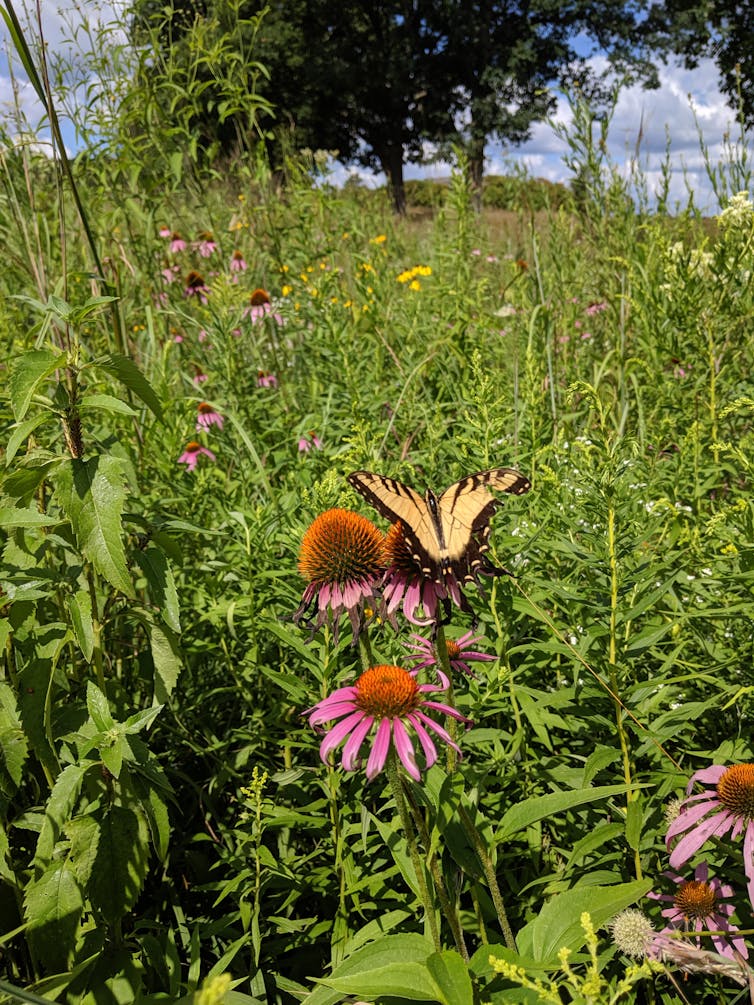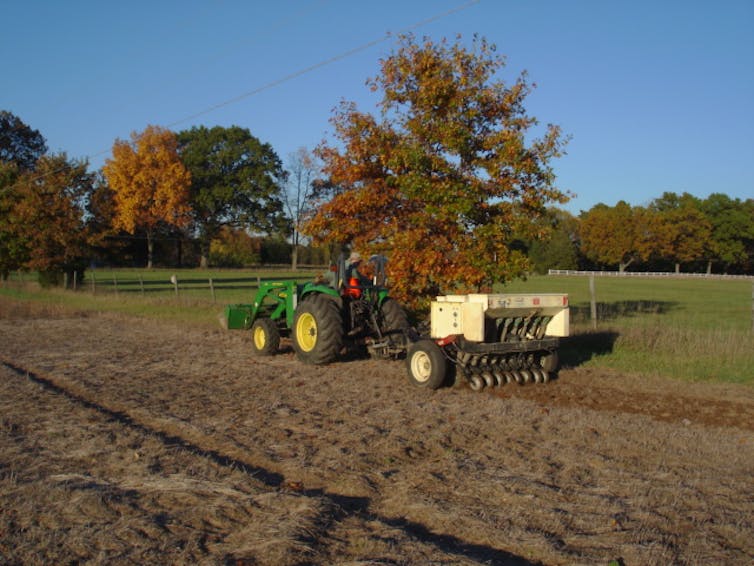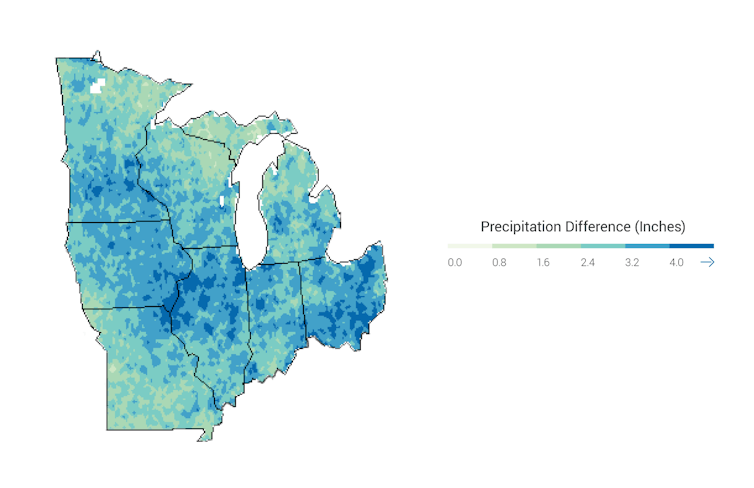Rain plays a surprising role in making some restored prairies healthier than others
Restoring former prairies that have been plowed under for farming delivers land, wildlife and climate benefits. But a new study finds that the weather plays a surprising role.

Prairies once covered an enormous area of North America, but today have been reduced to a small fraction of this historical range. Imagine an area the size of Texas, the second largest state, shrinking over the course of decades to an area the size of Massachusetts, the sixth smallest state.
Prairie grasslands produce a lot of benefits, such as storing carbon in soil, providing habitat for wildlife and protecting the land from erosion. Government agencies, conservation organizations and homeowners are working to restore native prairie ecosystems in many parts of the central U.S., but it’s a daunting challenge. Often newly planted restoration sites end up covered with weeds.
I am an ecologist and have worked with other researchers for a decade to find the most effective ways of restoring prairies in the midwestern United States. Our newest finding points to a reason why planted prairies can fail, one that few had considered earlier: the weather during the year they are planted.
Restoring ecosystems to solve environmental problems
Ecological restoration improves the health of ecosystems that have been degraded – for example, returning water to drained wetlands or replanting heavily logged forests. It’s an important strategy for tackling many of the world’s most pressing environmental challenges.
Research shows that repairing damaged ecosystems provides critical habitat for plants and animals. It slows the impacts of climate change by drawing down carbon dioxide levels in the atmosphere. It enhances crop pollination, prevents soil loss and keeps fertilizers out of waterways. For all these reasons, the United Nations recently declared 2021-2030 to be the Decade on Ecosystem Restoration.
But these projects can produce widely inconsistent results, even on similar sites where similar techniques have been used. Researchers are starting to understand that restoration success depends on multiple factors, but why some projects succeed and others fail is largely still a mystery. We want to predict outcomes so that agencies can direct scarce funding to sites where the work is most likely to succeed.

Decimated prairies
Before European settlement, prairies were the most expansive ecosystem in North America, covering much of the Midwest and Plains. Today, however, most of them have been converted largely to farmland, thanks to their fertile soil. Prairie grasslands are nearly extinct east of the Mississippi River.
As a result, a huge number of plant and animal species that once thrived in those regions have little habitat remaining. Some, like Poweshiek Skipperling butterflies and prairie fringed orchids, are now at risk of extinction.
By spreading the seeds of prairie plants onto old farmlands, land managers can restore these ecosystems. As new grasslands grow, managers periodically conduct prescribed fires and remove weeds with herbicides to promote the prairie plants. In time, insects and birds will return to restored prairies from nearby areas.
I’ve been to hundreds of restored prairies. Strikingly, no two have been the same. Some are rich communities of prairie plants, while others are packed with weeds – that is, nonprairie plant species. This variation can be vexing to land managers who are seeking to restore prairies in particular ways, for particular species.

In past studies, colleagues and I have identified a number of factors explaining why no two prairies are alike. They include specific soil type, the number of plant species spread as seed to initiate restoration and the frequency of prescribed fires. These findings show that although restoration outcomes vary, at least they do so for reasons that are either easily known or under land managers’ control. But our new research indicates that this isn’t always the case.
Rainy planting years cause problems
Land managers widely acknowledge that planting-year weather can affect a restoration, but up to now, few scientists had tested this idea. Restorations planted during rainy years should be more successful, meaning that they will support a greater diversity and abundance of the native plants that we seed on the land. But it’s hard to test this hypothesis because it requires many study sites, planted under differing weather conditions.
Our team worked at 83 restored prairies in Illinois, Indiana and Michigan that had been planted two to 19 years earlier. We recorded which plant species lived within each site, and then determined the weather conditions that affected each prairie during the year it was planted.
Our results were surprising. We expected that rainy years would promote successful restorations, but instead they produced prairies with more abundant and diverse weeds. These effects were comparable to or larger than the influence of other important factors such as soil conditions, the length of time since the last prescribed fire and the age of the project.
Weeds were more abundant in prairies that had been restored during rainy years as much as 19 years earlier. These sites also had relatively fewer native prairie plant species.
Why would dry planting years ultimately lead to more successful restoration than wet years, even though native prairie plants perform better with more water, as we showed in a previous study? Unfortunately, weeds are super-responders to water. We suspect that this explains why they gained dominance and suppressed prairie plants during wet planting years.

Working around the weather
Our results show that land managers need to guard against detrimental planting-year weather conditions – a challenge that is likely to become increasingly important in the future. Climate change is increasing springtime rainfall in the Midwest, which may particularly benefit weeds.
To manage the weed burden during wet planting years, managers can mow frequently, repeat seed-spreading in a later year or even avoid planting during anticipated high rainfall years. Humans can’t control the weather, but understanding how weather affects restoration can help managers maximize projects’ chances of success.
Anna Funk, a former graduate student at Michigan State University, was lead author of the study on which much of this article is based.
[You’re smart and curious about the world. So are The Conversation’s authors and editors. You can read us daily by subscribing to our newsletter.]
Lars Brudvig receives funding from the United States National Science Foundation.
Read These Next
Federal funding cuts are only one problem facing America’s colleges and universities
Amid federal funding cuts, the enrollment of both domestic and foreign students is falling at American…
Labeling dissent as terrorism: New US domestic terrorism priorities raise constitutional alarms
A new Trump administration policy threatens free speech and association by targeting individuals and…
Empathy and reasoning aren’t rivals – new research shows they work together to drive people to help
Those driven by both heart and mind help the most people, even far beyond their own circle.






